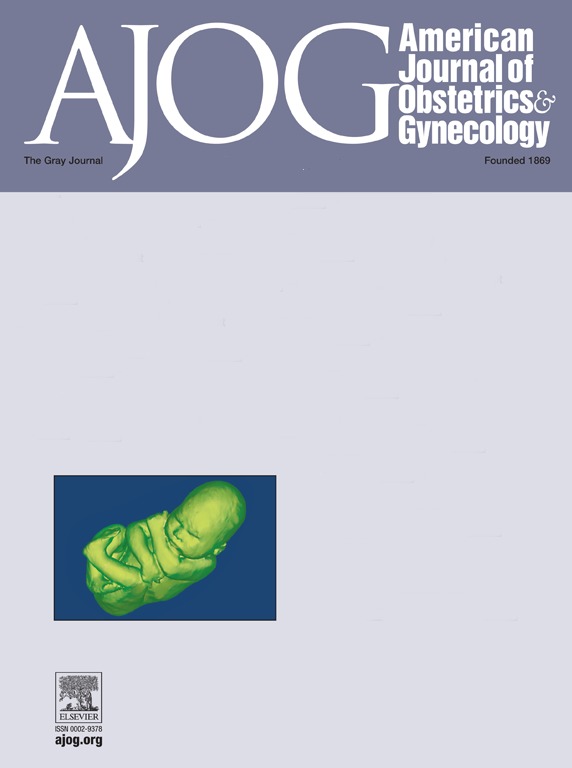The Combined Use of Cervical Ultrasound and Deep Learning Improves the Detection of Patients at Risk for Spontaneous Preterm Delivery.
IF 8.4
1区 医学
Q1 OBSTETRICS & GYNECOLOGY
引用次数: 0
Abstract
BACKGROUND Preterm birth is the leading cause of neonatal mortality and morbidity. While ultrasound-based cervical length measurement is the current standard for predicting preterm birth, its performance is limited. Artificial intelligence (AI) has shown potential in ultrasound analysis, yet few small-scale studies have evaluated its use for predicting preterm birth. OBJECTIVE To develop and validate an AI model for spontaneous preterm birth prediction from cervical ultrasound images and compare its performance to cervical length. STUDY DESIGN In this multicenter study, we developed a deep learning-based AI model using data from women who underwent cervical ultrasound scans as part of antenatal care between 2008 and 2018 in Denmark. Indications for ultrasound were not systematically recorded, and scans were likely performed due to risk factors or symptoms of preterm labor. We compared the performance of the AI model with cervical length measurement for spontaneous preterm birth prediction by assessing the area under the curve (AUC), sensitivity, specificity, and likelihood ratios. Subgroup analyses evaluated model performance across baseline characteristics, and saliency heat maps identified anatomical features that influenced AI model predictions the most. RESULTS The final dataset included 4,224 pregnancies and 7,862 cervical ultrasound images, with 50% resulting in spontaneous preterm birth. The AI model surpassed cervical length for predicting spontaneous preterm birth before 37 weeks with a sensitivity of 0.51 (95% CI 0.50-0.53) versus 0.41 (0.39-0.42) at a fixed specificity at 0.85, p<0.001, and a higher AUC of 0.75 (0.74-0.76) versus 0.67 (0.66-0.68), p<0.001. For identifying late preterm births at 34-37 weeks, the AI model had 36.6 % higher sensitivity than cervical length (0.47 versus 0.34, p<0.001). The AI model achieved higher AUCs across all subgroups, especially at earlier gestational ages. Saliency heat maps indicated that in 54% of preterm birth cases, the AI model focused on the posterior inner lining of the lower uterine segment, suggesting it incorporates more data than cervical length alone. CONCLUSIONS To our knowledge, this is the first large-scale, multicenter study demonstrating that AI is more sensitive than cervical length measurement in identifying spontaneous preterm births across multiple characteristics, 19 hospital sites, and different ultrasound machines. The AI model performs particularly well at earlier gestational ages, enabling more timely prophylactic interventions.宫颈超声和深度学习的联合使用提高了对自然早产风险患者的检测。
背景:早产是新生儿死亡和发病的主要原因。虽然基于超声的宫颈长度测量是目前预测早产的标准,但其性能有限。人工智能(AI)在超声分析中显示出潜力,但很少有小规模研究评估其在预测早产方面的应用。目的建立并验证基于宫颈超声图像的人工智能自然早产预测模型,并将其与宫颈长度进行比较。在这项多中心研究中,我们开发了一种基于深度学习的人工智能模型,该模型使用了丹麦2008年至2018年期间接受宫颈超声扫描作为产前护理一部分的妇女的数据。超声适应症没有系统记录,由于早产的危险因素或症状,可能进行了扫描。我们通过评估曲线下面积(AUC)、敏感性、特异性和似然比,将人工智能模型与宫颈长度测量在自发性早产预测方面的表现进行了比较。亚组分析评估了模型在基线特征上的性能,显著性热图确定了对人工智能模型预测影响最大的解剖特征。结果最终数据集包括4224例妊娠和7862例宫颈超声图像,其中50%为自发性早产。AI模型预测37周前自发性早产的敏感性为0.51 (95% CI 0.50-0.53),高于0.41(0.39-0.42),固定特异性为0.85,p<0.001, AUC为0.75(0.74-0.76),高于0.67 (0.66-0.68),p<0.001。对于34-37周的晚期早产,AI模型的敏感性比宫颈长度高36.6%(0.47比0.34,p<0.001)。人工智能模型在所有亚组中都获得了更高的auc,尤其是在妊娠早期。显著性热图显示,在54%的早产病例中,人工智能模型专注于子宫下段的后内层,这表明它比单独的宫颈长度包含更多的数据。据我们所知,这是第一次大规模、多中心的研究,表明人工智能在识别自发性早产方面比宫颈长度测量更敏感,涉及19家医院和不同的超声设备。人工智能模型在妊娠早期表现特别好,能够更及时地进行预防性干预。
本文章由计算机程序翻译,如有差异,请以英文原文为准。
求助全文
约1分钟内获得全文
求助全文
来源期刊
CiteScore
15.90
自引率
7.10%
发文量
2237
审稿时长
47 days
期刊介绍:
The American Journal of Obstetrics and Gynecology, known as "The Gray Journal," covers the entire spectrum of Obstetrics and Gynecology. It aims to publish original research (clinical and translational), reviews, opinions, video clips, podcasts, and interviews that contribute to understanding health and disease and have the potential to impact the practice of women's healthcare.
Focus Areas:
Diagnosis, Treatment, Prediction, and Prevention: The journal focuses on research related to the diagnosis, treatment, prediction, and prevention of obstetrical and gynecological disorders.
Biology of Reproduction: AJOG publishes work on the biology of reproduction, including studies on reproductive physiology and mechanisms of obstetrical and gynecological diseases.
Content Types:
Original Research: Clinical and translational research articles.
Reviews: Comprehensive reviews providing insights into various aspects of obstetrics and gynecology.
Opinions: Perspectives and opinions on important topics in the field.
Multimedia Content: Video clips, podcasts, and interviews.
Peer Review Process:
All submissions undergo a rigorous peer review process to ensure quality and relevance to the field of obstetrics and gynecology.

 求助内容:
求助内容: 应助结果提醒方式:
应助结果提醒方式:


